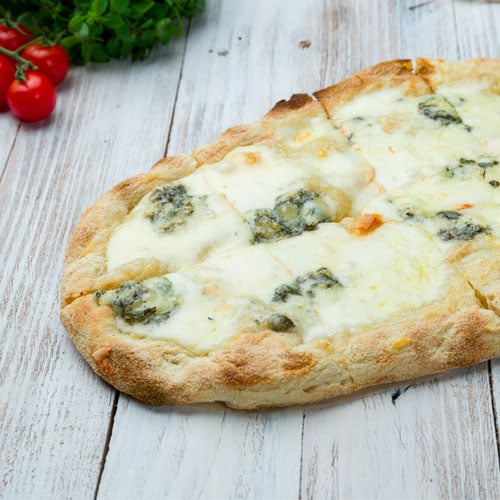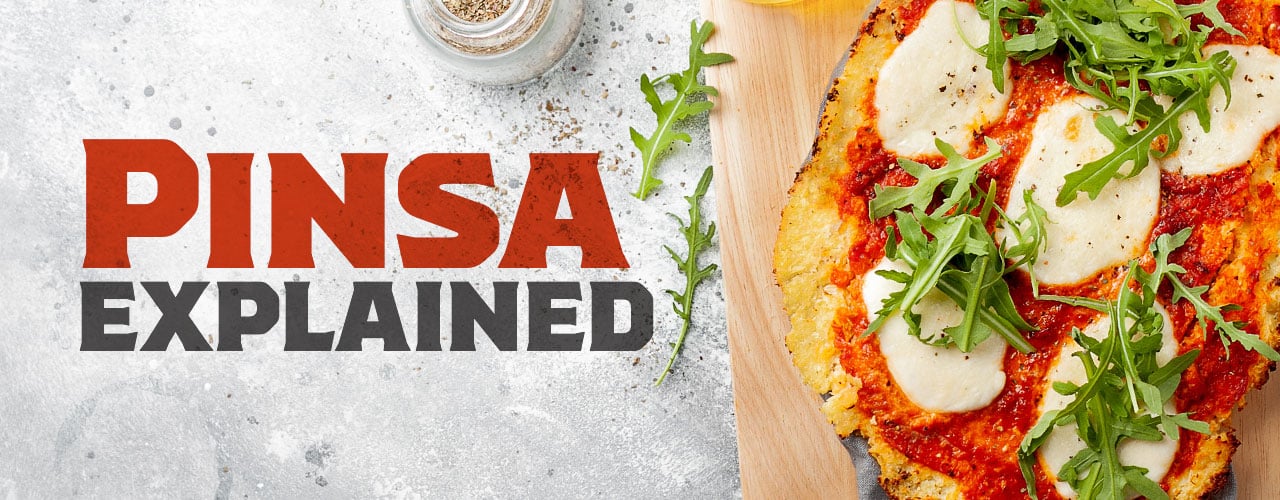It’s safe to say that pizza is one of America’s favorite foods. In just the United States, there are over 70,000 pizzerias that generate more than $32 billion in revenue annually. As the owner of a pizzeria, it can be tough to create a pizza that stands out from your competition’s signature pies. Many factors contribute to making an amazing pizza, but the secret lies in choosing the perfect cheese. We have done the research to see which cheeses will give your pizza the best look and taste. Shop All Wholesale Cheeses Use these links to navigate through our choices for the best pizza cheeses: 1. Mozzarella Cheese 2. Provolone Cheese 3. Cheddar Cheese 4. Parmesan Cheese 5. Gouda 6. Goat Cheese 7. Gruyere 8. Ricotta How Do You Choose Cheese for Pizza? Before you can select the perfect pizza cheese for your menu, it is important to understand what makes a cheese suitable for pizza. The following are characteristics to look for that make a cheese optimal for baking on pizza: Browning Capability - can turn golden brown through the Maillard reaction without burning Melting Ability - can evenly cover the surface without leaving lumps or becoming too thin Stretchiness - shows visible strands when pizza slices are pulled apart Fat Content - the milkfat by weight of the solids in a cheese is what makes it denser, helping it stretch and melt Moisture Content - the percentage of liquid in a cheese impacts its browning ability The best cheese for pizza should turn a light golden brown without burning in the high heat of the pizza oven. It should also have a low melting point to spread evenly over the crust and avoid clumping. The cheese should have a mild stretchiness so that it produces strands when pulled apart but not be too difficult to break when chewed. Pizza cheese typically has a low moisture level (~50-52%) and a low-fat content (~35-40%), which creates the desired melting and stretchability. Best Cheeses for Pizza Although there are various types of cheese available, not all belong on a pizza. Mozzarella, cheddar, parmesan, and provolone are the four main pizza cheese types, but many other cheese varieties can be incorporated into your gourmet pies to add a unique taste. Try incorporating some of the following types of cheeses for pizzas to create a versatile menu: 1. Mozzarella Cheese Mozzarella is the most popular cheese option for a pizza. It is a defining ingredient in Neapolitan pizza, but it is an ideal cheese for any pizza style. Since it’s minimally processed, it offers a fresh taste with a light and creamy texture. Mozzarella cheese was traditionally only made with Bufala milk, but now can be found with cow's milk in the ingredients. Look for a DOP logo if you are planning to serve the traditional variation. Difference between High and Low Moisture Mozzarella When making pizza with mozzarella cheese, you can choose between high and low moisture. High-moisture mozzarella has a very short shelf life and has to be used within the first day of being made. Low-moisture mozzarella has a longer shelf life with a saltier, denser flavor than high-moisture mozzarella. This low moisture component also helps it melt faster when being baked. Low-moisture mozzarella made with whole milk is the best option for pizza whether it's being used as the only cheese or added into a cheese blend. High-Moisture Mozzarella Cheese Characteristics Flavor: Creamy and mild Browning Capability: Pale to light browning Melting Ability: Medium, tends to retain shape Stretchiness: Low, tends to puddle Fat Content: 4.8 grams per 1 oz. slice Moisture Content: Very high (52%-60%) Low-Moisture Mozzarella Cheese Characteristics Flavor: Creamy with a slight tang Browning Capability: Light to medium browning Melting Ability: High, melts evenly Stretchiness: High, with visible strands Fat Content: 6 grams per 1 oz. slice Moisture Content: High (45%-52%) Using Mozzarella on Pizza Use low-moisture mozzarella for Margherita pizzas and high-moisture mozzarella for Neapolitan and Greek pizzas. If used alone, make sure to slice it thinly and drain any excess moisture from the cheese. Because mozzarella is so versatile, it is the number one cheese to be added to a cheese blend. Mozzarella can be blended with provolone to make a traditional cheese or pepperoni pizza. Mozzarella Pairings for Pizza The following toppings pair well with the mild and creamy flavor of mozzarella cheese: Pepperoni Basil Vienna sausage Tomatoes Salami Olives Red peppers Arugula 2. Provolone Cheese Provolone is a semi-hard Italian cheese and is the second most popular cheese to blend with other cheeses. The flavor of provolone varies greatly depending on how long it ages. If you want to add a sweeter flavor and creamier texture to your pizza, use a provolone that’s been aged for a shorter amount of time. To add a sharper taste and dryer texture, choose a provolone that’s been aged for longer. Provolone Cheese Characteristics Flavor: Sweet and creamy when young, sharp and dry when aged Browning Capability: Dark browning Melting Ability: High, melts evenly Stretchiness: Low to medium, with minimal stranding depending on age Fat Content: 7 grams per 1 oz. slice Moisture Content: High (45%) Using Provolone on Pizza Because of provolone's popularity among the pizza-making crowd, you can use it on just about any flavor or kind of pizza. Try to make an Italian tomato pie, St. Louis pizza, Greek pizza, or a Pinsa Romana with this versatile cheese. It won't disappoint! Provolone Pairings for Pizza Try some of the following toppings when using provolone cheese on pizza: Chicken Basil Pesto Tomatoes Onion Broccoli Red peppers Sausage Spinach 3. Cheddar Cheese Cheddar cheese is widely loved because of its sharp taste. People don’t tend to associate cheddar cheese alone as a cheese to be used on pizza because it doesn't handle high heat well. It's usually an ingredient in a lot of pizza cheese blends. Cheddar is a good addition to any pie because its lower elasticity means it doesn't blister as easily as mozzarella. Also, if you choose a sharper cheddar cheese that has a deep orange tint, it will add color to your pizza. Cheddar Cheese Characteristics Flavor: Sharp, earthy, and pungent, sharpness is more intense in darker-colored cheddars Browning Capability: Medium browning Melting Ability: Low, fats can separate from solids in high heat Stretchiness: Low, with minimal stranding Fat Content: 9 grams per 1 oz. slice Moisture Content: Medium (34-45%) Using Cheddar on Pizza Although cheddar isn't a great option alone on pizza, it lends itself well to cheese blends to add color to your mix. Feel free to get creative with cheddar cheese and the types of pizza you want to create. Because of the versatility that cheddar cheese offers, you can add toppings like savory meat or sweet pineapple to create a unique menu. Cheddar cheese is also commonly used on specialty pies like chicken bacon ranch, cheeseburger, and buffalo chicken pizzas. Cheddar Pairings for Pizza If you're using cheddar on pizza, pair it with some of these toppings: Pepperoni Ham Bacon Pineapple Chicken Caramelized onion Capers Broccoli 4. Parmesan Cheese Parmesan cheese, in addition to other aged Italian hard cheeses, can be shaved or shredded on top of freshly baked pizzas. It should never be blended into your cheese mixes and due to the delicate flavor and dryness of this cheese, it should never be baked in the oven. When cheeses like parmesan are exposed to heat, their umami taste is ruined. Instead, use parmesan as a garnish on your pizzas to enhance the flavor of the whole pie. Parmesan Cheese Characteristics Flavor: Nutty, slightly sweet Browning Capability: Very dark browning, tends to burn Melting Ability: Very low, will crisp instead of melt Stretchiness: Very low, snaps instead of stretches Fat Content: 1.4 grams per 1 Tbsp. Moisture Content: Low (13-34%) Using Parmesan on Pizza If you are a cheese lover, parmesan cheese, like Parmigiano-Reggiano, is probably one of your favorite go-to cheeses to sprinkle on top of your pizza. Putting parmesan cheese on any pizza will do, but we recommend it specifically for Sicilian, Margherita, or Hawaiian pizzas. This cheese will accentuate the taste of other fresh and flavorful toppings. Parmesan Pairings for Pizza Combine the savory flavor of parmesan with the following toppings on pizza: Mozzarella cheese Provolone cheese Bacon Broccoli Prosciutto Arugula Back to Top 5. Gouda Gouda is a semi-hard Dutch cheese known for its rich, unique flavor and smooth texture. Older gouda will have less moisture and a tangier flavor than young gouda. Because of its versatile flavor profile, gouda is a delicious addition to pizzas featuring pulled pork or barbecue chicken. Plus, it’s available in straight or smoked, so you can pick the option that will best bring out the other flavors on your pizza. Gouda Cheese Characteristics Flavor: Buttery and smokey Browning Capability: Medium to dark browning Melting Ability: Low to medium, doesn't soften easily, younger gouda will melt more easily Stretchiness: Low, pools rather than pulling into strands Fat Content: 8 grams per 1 oz. slice Moisture Content: Medium to high (35%-55%) Using Gouda on Pizza Because of gouda's buttery flavor, it tends to work well for flatbread and thin-crust pizzas that balance sweet with savory flavors. Gouda is most popularly paired with barbecued meats because of the natural smokiness of the cheese. Gouda Pairings for Pizza Here are the pizza toppings that pair well with gouda cheese: Pulled pork Barbecue chicken Spinach Mushrooms Red onions Garlic Olives Sausage Bacon 6. Goat Cheese Goat cheese is made from goat's milk. It is soft and creamy when young and can be mixed with other flavors like berries or herbs. As it ages, it dries into a hard cheese that can be preserved in a rind. Goat cheese is known for its earthy and tart flavor, which can bring a unique twist to your pizza. Goat Cheese Characteristics Flavor: Tart and earthy Browning Capability: Light to medium browning Melting Ability: Low to medium, becomes creamy but can separate if overheated Stretchiness: Low, tends to pool Fat Content: 8 Grams per 1 oz. slice Moisture Content: High to very high (53%-59.8%) Using Goat Cheese on Pizza Although goat cheese doesn’t melt like mozzarella and provolone do, it softens up very nicely when cooked in the oven. Goat cheese makes a great addition to flatbread pizzas, focaccia pizzas, and Mediterranean pizzas. Try dropping small dollops of goat cheese across your pie’s surface. This will give customers a burst of savory taste as they take each bite. Goat Cheese Pairings for Pizza Try goat cheese on your pizza with some of the toppings below: Caramelized onions Figs Peppers Arugula Basil Mushrooms 7. Gruyere Gruyere cheese is a type of Swiss cheese made from whole cow's milk. It is a hard cheese but melts very nicely and has a mild savory flavor. When eating gruyere, you experience a range of flavors, starting with sweet and ending with nutty and earthy. Gruyere Cheese Characteristics Flavor: Nutty, sweet, and earthy Browning Capability: Medium browning Melting Ability: High and even Stretchiness: High, becomes gooey with visible strands Fat Content: 9 grams per 1 oz. slice Moisture Content: Medium (39%) Using Gruyere on Pizza Gruyere is a popular cheese to use on traditional pizza slices. The sweet and nutty flavor pairs well with red or white pizza sauces. Because gruyere cheese melts evenly and doesn’t blister easily, it is a great cheese for any pizza. Gruyere Pairings for Pizza Enjoy some of these pizza toppings with gruyere cheese: Potatoes Peppers Prosciutto Sausage Caramelized onions Spinach Red onions Pesto 8. Ricotta Ricotta cheese is made from the whey that's leftover from cow's milk, goat's milk, or buffalo's milk. This soft Italian cheese has a mild and slightly sweet flavor with a rich and creamy texture. It lends itself well to many Italian dishes, including pizza, pasta, and even cannolis. Ricotta Cheese Characteristics Flavor: Fresh, milky, and slightly sweet Browning Capability: Pale to light browning Melting Ability: Very low, retains shape in high temperatures Stretchiness: Low, becomes creamy instead of stretching Fat Content: 16 grams in 1/2 cup Moisture Content: Very high (55%-80%) Using Ricotta on Pizza Because of ricotta's creamy consistency, it is used as a base cheese for white-sauce pizzas, like Pizza Bianca and grilled flatbread pizzas. Ricotta cheese can be blended with mozzarella, fontina, gruyere, or gorgonzola cheese to make a creamy base. Its fresh flavor pairs well with seafood and vegetables. Ricotta Pairings for Pizza Ricotta pairs nicely with these pizza toppings: Chicken Shrimp Basil Tomatoes Charred spring onion Broccoli Kale Artichokes Spinach Roasted garlic Back to Top Now that you know the characteristics of each cheese type and the most compatible pizza toppings, you can begin experimenting by adding in some specialty cheeses. Whether you're making a pizza as a staple on your menu or just as a specialty item offered at your restaurant once a week, it's important to find a cheese that works for your pizza! Enjoy making wonderful pizza for all of your customers.





